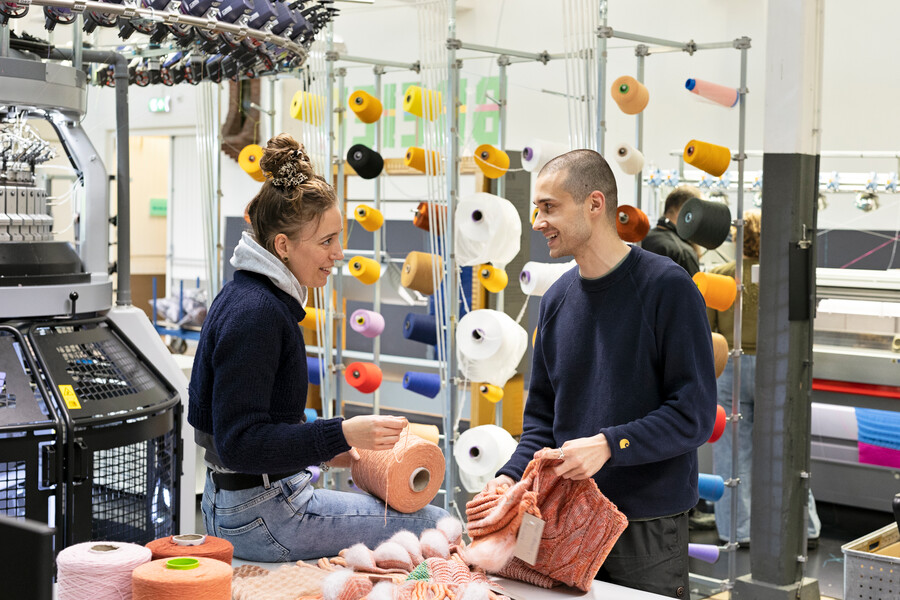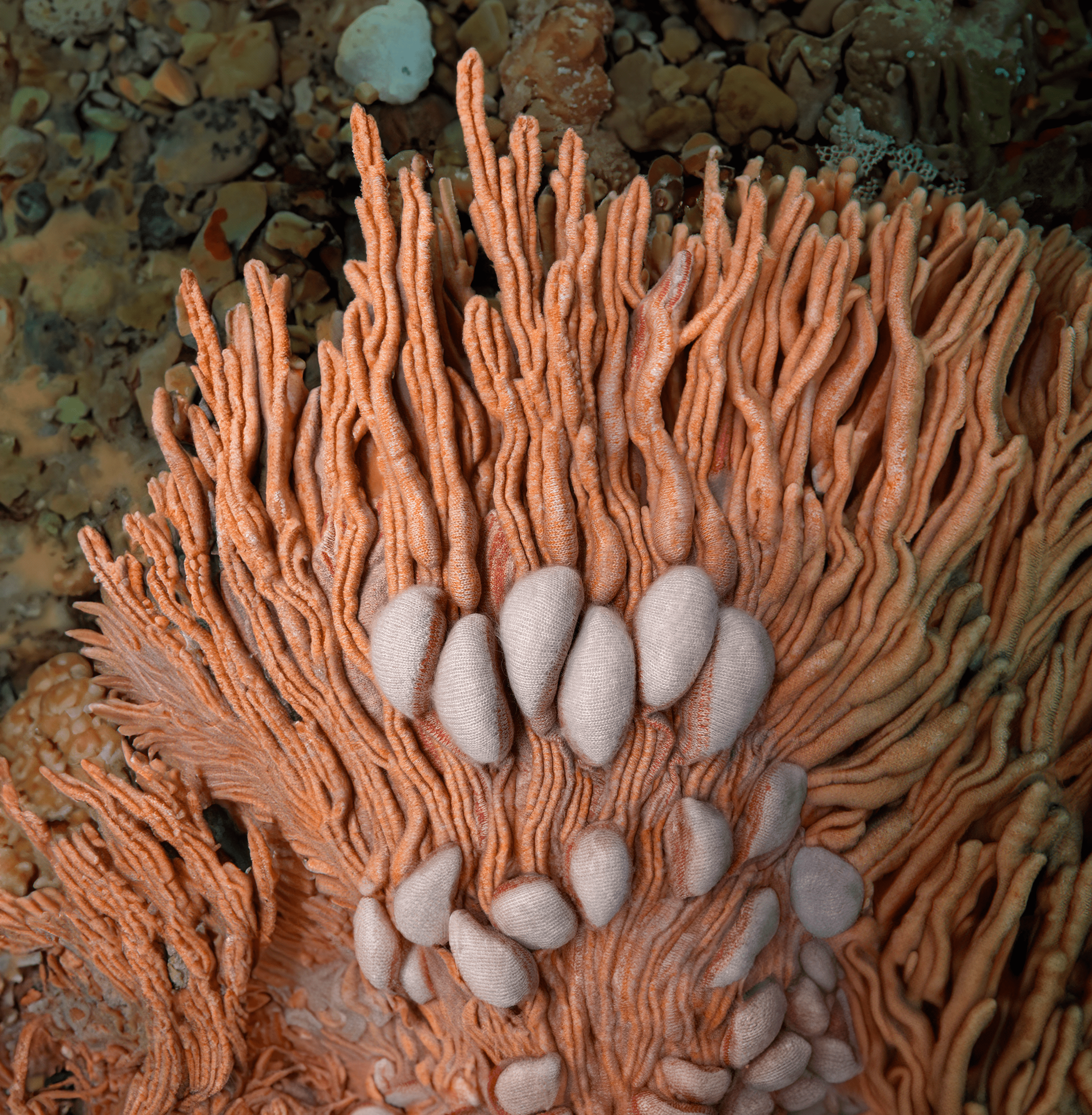Belgian AI artist Elmo Mistiaen makes ‘biomorphic outdoor fashion & weird design’. Product developer Sarena Huizinga is turning his digital creations into tangible items on the flat knitting machines. These will ultimately become a sculptural piece that explores an alternative evolution.
Elmo Mistiaen has been fascinated by insects since he was a child. “I saw them as aliens living among us,” he says. While studying business engineering at the Vrije Universiteit Brussel, he continued playing with this idea in his spare time. Using AI, he enlarged microscopic organic shapes to human size and assimilated them into fictional body pieces. The designer in him eventually won out: since graduating, he has been creating digital fantasy worlds in which he blurs the line between people and nature.
Symbiosis
Mistiaen’s creations provide humans with alienating shapes, textures and tools from the insect world. “I’m looking for the symbiosis between the two,” he explains. “What if hikers had an organic backpack that grew wings? Or if you wore a kind of bio-membrane as a second skin, which protects you against dangerous external influences? Could we have evolved that way under different circumstances?”
The worlds that Mistiaen builds – with the exception of his jewellery line Miosis – have only existed digitally. Until now. In the TextielLab, he is experimenting with ways to make these digital creations tangible. The project is part of the lab’s fully fashioned knitting R&D programme, for which Mistiaen was invited to spend a year translating his images into 3D knitted body art with product developer Sarena Huizinga. Their collaborative style is notable.
Impossible knits
Although the garments in Mistiaen’s images appear completely lifelike, he has never worked with textiles in the analogue world. The programmes Huizinga is writing for the knitting machines are based on an AI photo. “The objects in the photo really look knitted, but they aren’t,” she says. “A lot of what you see is actually impossible. That really inspires me because it requires a completely different way of thinking.” A lot of time has been built into the R&D programme for experimenting, which gives Huizinga plenty of creative freedom. Since February this year, she has been regularly making new samples, pushing the limits of the machines and exploring ways to add even more three-dimensionality.

Elmo Mistiaen and product developer Sarena Huizinga at the TextielLab. Photo: Josefina Eikenaar
“You have to understand how AI works to get something good out of it.”
Elmo Mistiaen
Artificial evolution
The samples are not only based on insects but on numerous intriguing natural forms, including from the underwater world. Huizinga safeguards a box full of precious orangey-pink samples covered with scales, lobes, bumps and ridges, which were based on the first images. Mistiaen photographs the samples, imports them into his AI tool and lets them evolve rapidly in the digital world. He then shows Huizinga these images in which the photos of samples have grown into something much bigger. This creates a feedback loop between designer and product developer in which they continually inspire each other to take the next step.
Co-creation with AI
Artificial Intelligence is a crucial tool in Mistiaen’s work. While some see the rise of artificial intelligence as a threat, he embraces it. “AI allows you to expand your own style in an unprecedented way. What I find most interesting is using your own images as source material. For example, I take a photo of my hand, which I then transform into a butterfly wing or crab leg. It’s truly a co-creation between the artist and AI. The trick is to maintain control. You have to understand how AI works to get something good out of it.”
Mother creature
At the halfway point of the process, it is time to merge all the experiments into something bigger. A central part of the R&D programme is the development of a voluminous and sculptural body piece for the exhibition SHAPE – body, fashion, identity, which will be on display in the TextielMuseum from mid-November. “So far, the project has been very exploratory,” says Mistiaen. “I’m now using the samples to create a new shape that brings interesting results together. I’m very happy with the bulging pockets we knitted, into which we can insert small, knitted eggs or larvae. It might eventually become a kind of mother creature, an organism that celebrates the birth of a new world.”
Microbe yarn
Previously, Mistiaen had focused mainly on technical outdoor fabrics. However, during the sampling process, he discovered the special properties of wool. “When you wash wool, it felts, and straight shapes are contorted. That makes it even more organic.” The wool in the final work will be locally grown, in response to Mistiaen’s desire to work with sustainable yarns. The team also recently tested a highly innovative yarn made with microbes. It is the first time that the lab has worked with a man-made protein yarn, which is produced through microbial fermentation using waste sugars from the sugarcane industry. In this way, a project that brings together analogue and digital in an unusual way is also creating unusual combinations between traditional and innovative technical yarns. Says Mistiaen: “For example, we are currently experimenting with shiny silk for a wet effect. That fits the creepy shapes.”

AI-generated image in which the photo of a knitted sample has developed into something more. Image: Elmo Mistiaen
Text: Willemijn de Jonge